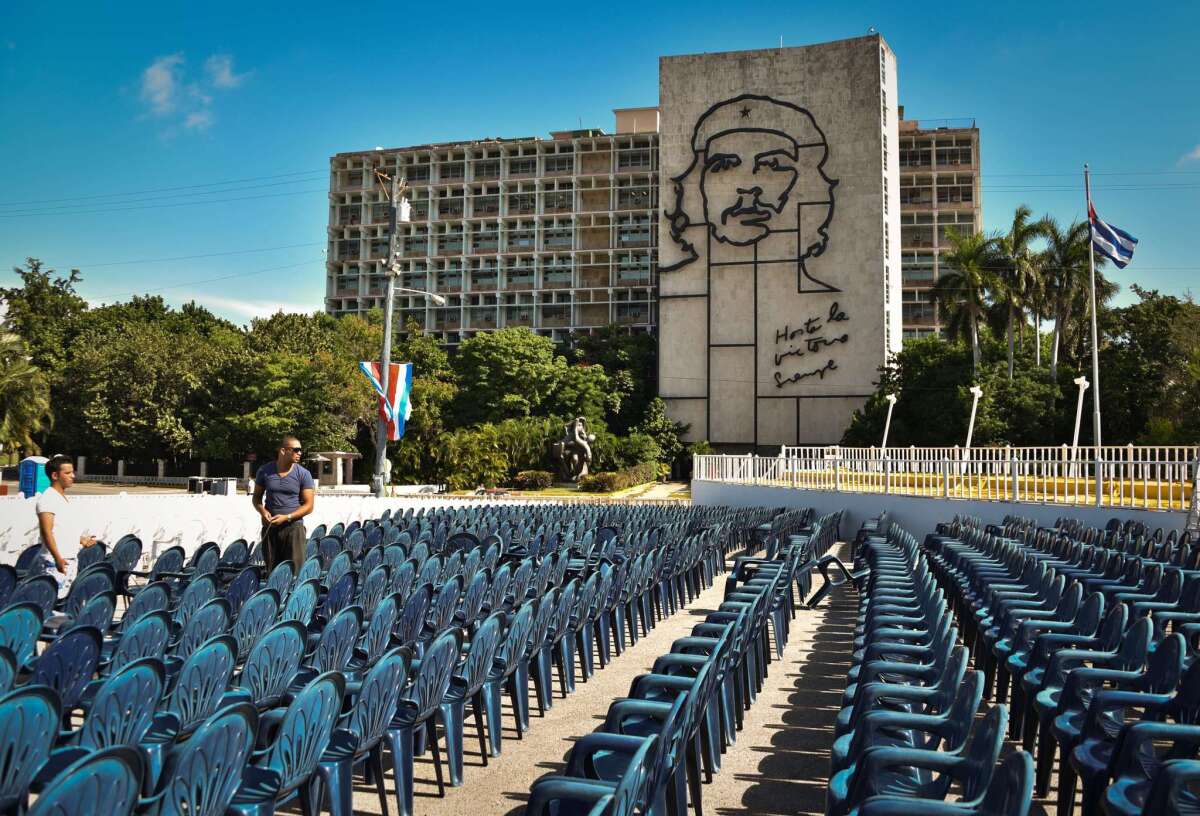Pope Francis heading for Havana in first leg of reconciliation tour

View of Revolution Plaza in Havana on Friday, where Pope Francis is due to celebrate Mass on Sunday.
- Share via
Reporting from Bogota, Colombia — Having helped engineer the historic rapprochement between the United States and Cuba, Pope Francis lands in Havana on Saturday afternoon, the first leg of a nine-day trip that includes stops in Washington, New York and Philadelphia.
The visits to both countries underscore the lessening of tensions with the formal reestablishment of diplomatic relations in July. While in Cuba, the pope may reiterate the Catholic Church’s longstanding position that the U.S. lift its trade embargo because of the suffering it causes among poor Cubans.
The pope played a pivotal role in negotiations that led to last December’s announcement of a resumption in relations. Francis hosted meetings at the Vatican between U.S. and Cuban negotiators and had sent letters to President Obama and Cuban President Raul Castro to urge an accord.
Obama has on numerous occasions credited Francis for his diplomatic efforts, which also led to the release of U.S. consultant Alan Gross last December from a Cuban prison. Gross, who had been held for five years on espionage charges, was exchanged for three Cubans locked up in the U.S. on spying charges.
Analysts say Francis is likely to advance church initiatives in Cuba, specifically to gain permission to re-open Catholic schools, which have been closed since shortly after the Communist revolution in 1959 that brought Fidel Castro to power. The church would also like to produce radio and television programs and disseminate literature.
The first Latin American elected pope, Francis, 78, will maintain a hectic three-day agenda, celebrating Mass in Spanish in Havana, Holguin and at the country’s most revered Roman Catholic shrine at El Cobre near Santiago de Cuba.
Raul Castro is due to attend each Mass, having made a surprise announcement in May after meeting with Francis at the Vatican that the pope had inspired him to consider rejoining the church. The Vatican has said the 78-year-old pope has requested a meeting with Fidel Castro, 89, his frail health permitting. Both Castro brothers attended a Jesuit high school in Havana called Colegio Belen.
The Cuban visit is the third by a head of the Roman Catholic Church. Pope John Paul II stopped on the island in 1998 and Pope Benedict XVI in 2012. Earlier this month, the Cuban government announced it would release 3,522 prisoners ahead of the upcoming visit, but apparently none of them are political detainees. Similar releases were made prior to previous papal visits.
The visit reflects the church’s improved standing in Cuba, where about one-quarter of the population is considered practicing Catholics. Since the 1980s, Cuba has slowly allowed more freedoms to the church, two decades after having forced most priests and nuns to flee the country.
Dual membership in the Communist Party and the Roman Catholic Church has been allowed since the early 1990s, following three decades of enforced atheism. Christmas and Good Friday were declared national holidays following Pope John Paul II’s visit after years of status as work days.
Recently, the church was granted permission to build the new cathedrals for the first time since the Communist revolution. The church is now permitted to run after-school and elderly programs as well as community centers with funds partly provided by the Vatican.
The pope’s role in reconciling the U.S. and Cuba speaks to his Latin American roots as much as the church’s policy priorities.
“With his background, Francis knows firsthand how divisive the U.S.-Cuba conflict has been for the hemisphere in past decades and he is a man who wants to resolve conflicts,” said Enrique Pumar, a native Cuban who is now a sociology professor at Catholic University of America in Washington. “The church would also like to gain political leverage in a country where it wants to play a bigger role, especially in education.”
Matthew Carnes, a Jesuit priest and assistant professor of government at Georgetown University, said the pope’s trip will “burnish the church’s image” for its direct role in the U.S. and Cuba accord, but also attempt to advance religious freedom on the island.
“Practicing Catholics have persevered through great adversity with a regime that has not been supportive so I’m sure the pope will ask the regime to revisit its policies,” Carnes said.
In its relations with the Castros, the church walks a tightrope with a tacit understanding that, in exchange for more freedoms, it keeps any demands for more human rights on low volume, said Pumar. Havana’s Cardinal Jaime Ortega, a close friend of Francis, has been criticized by human rights groups for not taking a more activist human rights role.
Havana is being spruced up for the visit, the highlight of which is expected to be a Mass on Sunday in Revolution Plaza, which features an image of the pope’s fellow Argentine, revolutionary icon Ernesto “Che” Guevara.
The pope will then travel to eastern Cuba, culminating in a Mass on Tuesday at the Basilica of the Shrine of Our Lady of Charity, Cuba’s patron saint, at El Cobre, a former copper mining town near Santiago. He departs that afternoon for Washington and is due at the White House on Wednesday.
Kraul is a special correspondent.
More to Read
Sign up for Essential California
The most important California stories and recommendations in your inbox every morning.
You may occasionally receive promotional content from the Los Angeles Times.










